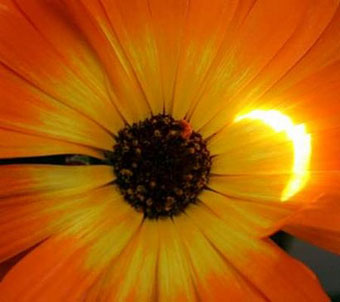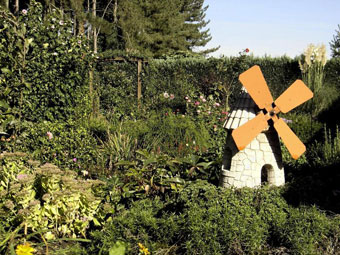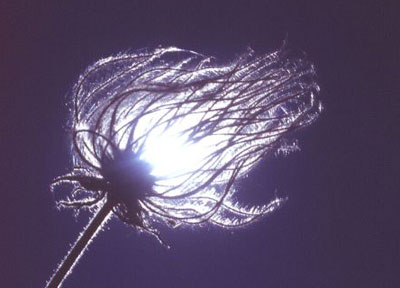Human Flower Project
Wednesday, March 29, 2006
Flowers & Eclipses
A solar eclipse brings hush, grey light and—for some flowers— a strange nap.

Partial solar eclipse, Amman, Jordan: March 29
Photo: Ali Jarekji, for Reuters
While others were straining to look through safety telescopes or special protective glasses, Ali Jarekji of Reuters sighted today’s eclipse on flower petals (via a pinhole, we suspect). The golden crescent of partial eclipse appeared on a flower in Amman, Jordan, and Jarekji had the brilliance to capture it with his camera.
The path of the eclipse began in Brazil, touching (among other lands) Ghana, Libya, the Greek Island of Kastellorizo, and Turkey, before “setting” in Mongolia at 11:48 GMT.
“It was more fabulous even than we expected,” said Jay Pasachoff, a U.S. astronomer, viewing his 42nd solar eclipse. “It’s one of those experiences that makes you feel like you’re part of the larger universe,” said Janet Luhman, a scientist with NASA.
 A garden, under 60% solar eclipse, March 2003
A garden, under 60% solar eclipse, March 2003
Photo: Haneveercoreman
As a new moon passes between the sun and Earth, the light becomes green-gray. The picture at right shows an eerie garden during an eclipse March 10, 2003.
In some cultures, this sudden nightfall during the day was cause for serious self-appraisal. Here’s a bit of Ethnoastronomy from Lithuania.
Until recently, “the belief was still alive that during solar eclipse it’s best to stay at home, pray and beg God to forgive our sins and protect from disaster. When at home close window shutters and cover the windows. Sometimes (people) lit candles and burn(ed) the Sunday palm flowers. The cattle would be kept inside the sheds in fear that during the solar eclipse they may contract a disease or get blind if they stay outside. It is said that during solar eclipse the cattle would make wild sounds and bend on their knees.”
Birds and flowers are likewise subdued. Daytime bloomers—like gazania, poppies, tulips and portulaca—all close as the moon intervenes. Perhaps they “think” it’s night or —like early Lithuanians—they, too, feel chastened.

Wild Flower Eclipse
Photo: by John Foster
This site notes: “There may well be sudden bursts of wind around totality – resulting from the sudden change in temperature. Watch for unusual patterns and shadows on the ground and on buildings. Watch the behaviour of people around you!”
Good advice, eclipse or no.
(Many thanks to John Foster of Portland, OR, for permitting us to post his fine photo of what happens when a wildflower passes between the sun and Earth.)




